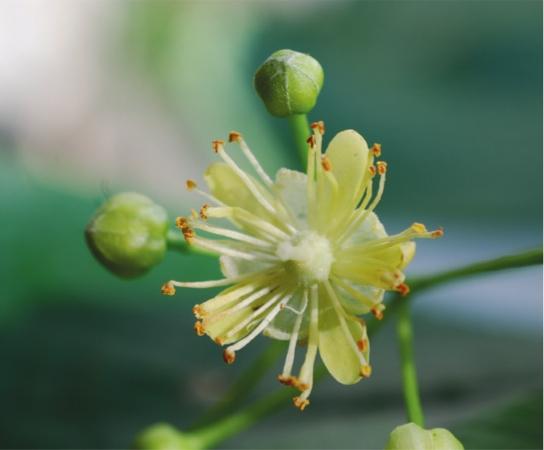The perfect remedy for stress, tension and overwork, lime blossom helps us relax and sleep well. It soothes irritation, boosts the immune system and protects the heart by reducing cholesterol levels and relaxing the arteries.
Linden tea is widely enjoyed in France where it is drunk as a daily beverage for its pleasant honey-like taste and its health benefits. It is also wonderful for children.

Tiliaceae Lime family
Description: Tall, elegant trees that bear deciduous, heart-shaped leaves and fragrant flowers in summer.
Habitat: Woods, hedgerows, parks and gardens.
Distribution: Common lime is widespread, though often planted. Small-leaved lime is found in much of England and Wales, while large-leaved lime is most common on the English–Welsh borders.
Species: Common lime (Tilia x europaea) is the hybrid of the two species native to the British Isles, small-leaved lime (T. cordata) and large-leaved lime (T. platyphyllos). Any of these three can be used.
Parts used: Flowers, picked when the first flowers in each bunch have opened in summer.
There is nothing quite like walking under lime trees when they are in full flower in early summer, drowsily fragrant and loudly humming with the buzz of hundreds of honeybees. Bees adore lime blossom, and make a flavoursome honey from it that retains the calming effects of the flowers.
Linden’s heady scent does have an uplifting effect on consciousness, and in folklore it was said that if you fell asleep under a lime tree you could wake up in fairyland. More practically, if you park your car under one in high summer, it will be covered with sticky droppings of honeydew from greenfly that live on the leaves.
The name lime can be confusing, as many of us think of lime fruit, a relative of the lemon. All that links the two is the colour, which is similar in the leaves of linden trees and the citrus fruit. There is also no connection with limestone.
The blossom season is short and can easily be missed, especially if the weather is bad.
Use lime or linden for…
Medicinally, lime blossom is best known as a calming, relaxing remedy. It can be used to treat high blood pressure, and arteriosclerosis, particularly where stress and anxiety are major factors. It is a circulatory relaxant, working to destress the arterial walls.
Relieving tension as it does, linden encourages a restful relaxing sleep, helping you wake refreshed and clear-headed. It was recommended as a sedative on the home front during the Second World War.
The tea, drunk hot, promotes sweating. This can be used to ‘break a fever’, with sweating being the body’s natural way of preventing a fever from burning too hot, while also helping eliminate toxins through the skin and clearing them through the urine. If the linden infusion is drunk cool, it is cooling to the body and useful for treating the hot flushes associated with menopause. Cold linden tea makes a delightful light summer drink on a hot day.

Linden is also warming and relaxing to the digestive sytem. It can help whenever tension goes to the digestive tract, either through eating on the run or through general anxiety. Related tension conditions, like cramps, colic and period pains, can also be alleviated.
Being a gentle remedy with a pleasant taste, linden is particularly good for treating children. It quietly calms an overactive or fractious child, soothing and relaxing them. It is effective when they have nervous digestion or trouble sleeping, and can also be used for coughs and colds and ’flu, alone or with elderflower.
Externally, the tea can be rubbed into the skin to give relief in inflamed conditions such as boils, rashes, bites, scalds and burns, or used for sore eyes. It is also soothing in a bath or for massage.
Homeopathically, linden has much the same uses as the herb, being specific for children’s toothache and women’s pelvic inflammation. The inner bark of linden is known as bast (bass in the United States, giving basswood, another name for the tree). Bast can be made into a tea that is soothing for diarrhoea.

Linden tea
Use the new flowers and unopened buds, with their stalk and leaf sheath. Pick on a dry sunny day, and avoid any blossoms with a blackish mildew growing on them. The lime blossom season is very short, with the blossoms only at their best for about a week, so if the weather is wet during this time you are better off tincturing the blossom than drying it.
Dry the flowers out of the sun until they are crispy. Once dry, you can remove the larger stalks and store the blossom in paper bags or jars in a cool dark place. If exposed to light, lime blossom will soon deteriorate. If it turns a pinkish colour, it should be discarded.
Use a heaped teaspoonful of dried blossom per cup of boiling water in a teapot, and infuse for about 5 minutes. This is a good evening drink as it will relax without being too sedative. Drink a cupful one to three times a day for anxiety or restlessness. For colds or fevers, drink small amounts of the hot tea throughout the day to soothe, clear catarrh and promote perspiration. Drink cold for hot flushes.
Linden tincture
Fill a jar with the freshly picked blossom, and top it up with vodka. Leave it in a cupboard for two weeks, shaking every few days. Strain, bottle and label.
Dose: Half a teaspoonful 2 or 3 times a day.

Small-leaved lime, Bardney Woods, Lincolnshire, June